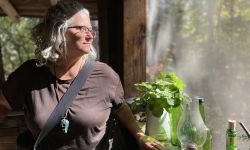Opinion | In Michigan, clean energy and agriculture are allies, not enemies
Michigan is in the midst of big moves to solidify its transition to clean energy, with several pieces of legislation that would codify the MI Healthy Climate Plan, with a goal of the state’s electric grid running on 60 percent clean energy by 2030 and 100 percent by 2040, into law.

All experts and observers agree that this goal will likely not be reached unless it becomes easier to site and permit wind, solar, energy storage projects so enough of these resources can be built to power the state for decades to come.
An essential piece of this legislative push came recently when a set of bills was introduced in Lansing. They are designed to streamline the process for siting and permitting renewable energy and energy storage projects while ensuring local residents of areas affected by these projects have a seat at the table.
Almost immediately, opponents of more clean energy pitted the support and opposition of the bills as a contest between project developers on one side and rural areas where these projects tend to be located on the other. Making it easier to build clean energy in rural areas is being portrayed as a negative for those areas, with some even claiming that the bills amount to “war” being declared on agricultural districts.
This framing is more than just inaccurate. It is the opposite of the truth. A look at how renewable energy has actually been deployed throughout the country and world shows a mutually beneficial relationship between clean energy and agriculture that is financially and environmentally productive for both parties and the communities, states and countries where these projects are built.
Here’s an example. At a Michigan House Energy, Technology and Communications Committee hearing on Oct. 11, Clara Ostrander, whose farmland in Monroe County has been in her family for over 150 years, spoke passionately in favor of the legislation. “I… hope you vote to protect the property rights of Michigan farm families by voting yes on these bills,” she said.
Her rights badly need protecting because Ostrander, along with many other farmers across the state, are trying to save their legacies in an economy where the rising prices of fuel and fertilizer are threatening them.
Ostrander explained that her situation reminds her of a time in the 1990s when her father had to sell a portion of the family’s land to pay for rising medical bills. Today “our greatest fear is that we will have to do the same thing my dad did and sell the rest of the farm… instead of being able to pass it on to the next generation,” she said in her testimony.
A few years ago, an offer to lease part of her land to a planned solar project provided a lifeline for Ostrander. What followed was a textbook example of the kind of roadblocks that have made it unnecessarily difficult to build clean energy projects. “A few loud voices began to spread falsehoods and misinformation about the project,” she testified, and those opposition efforts led to the project being placed on hold.
Residents of her township were “lied” to by people who don’t want the view from their own property to change, Ostrander said. But “they don’t own their view. Their view is farmland that families like mine have tended, preserved and paid taxes on for generations. They should not get to decide what we grow or what we harvest, and that includes harvesting the sun for electricity,” Ostrander said.
While there are too many stories like Ostrander’s where opposition leads to projects being stalled, when projects are allowed to be built, all across the state renewable energy is helping farmers stay on their land and pass that property down to future generations. The projects also financially benefit the surrounding community. For example, tax revenue from wind projects built in mid-Michigan is allowing multiple school districts in that part of the state to upgrade school buildings without having to raise taxes on residents.
But the benefits go beyond money. Renewable energy can be restorative for agricultural land, as seen in Branch County, where landowners leasing to solar projects see the lease as an opportunity for their land to “rest and rejuvenate” without insecticides.
State policy currently allows land that participates in Michigan’s Farmland Preservation Program to allow solar energy deployment so that land continues to be for agricultural uses in the long run, and a bill that would codify that policy into law recently passed the state Senate.
The synergy between solar panels and agriculture has been so strong that around the country and world there has been a growing practice of “agrivoltaics,” where solar panels do not replace crops, but are installed over them or in conjunction with them.
A number of best practices for placing renewable energy on agricultural land have developed over the years, leading to agrivoltaic approaches that can increase the health and yield of crops and allow renewable energy to improve the condition of agricultural land.
Shading from solar panels has a cooling effect that has helped winemakers grow grapes in France and made broccoli grown in South Korea more green. When flowers and other plants are grown beneath solar panels, a solar project becomes a home to pollinators, and research has shown an increase in crop yields on pollinator-dependent farmland sited next to solar projects. The benefit goes both ways, as vegetation under solar panels increases ground shade and humidity that help the panels run more efficiently.
It is not just solar that has synergy with agriculture, either. Iowa State researchers have found that wind turbines create air movements that draw carbon dioxide out of soil, increasing photosynthesis and helping crops grow.
Clean energy and agriculture are allies, not enemies. Wind, solar and storage projects support farmers, support local communities, and benefit farmland. It is imperative that these projects are reviewed and assessed based on the facts, not falsehoods and misinformation.
See what new members are saying about why they donated to Bridge Michigan:
- “In order for this information to be accurate and unbiased it must be underwritten by its readers, not by special interests.” - Larry S.
- “Not many other media sources report on the topics Bridge does.” - Susan B.
- “Your journalism is outstanding and rare these days.” - Mark S.
If you want to ensure the future of nonpartisan, nonprofit Michigan journalism, please become a member today. You, too, will be asked why you donated and maybe we'll feature your quote next time!




